Helping Banks Compete Through Innovation — Interview with Jan Schütz
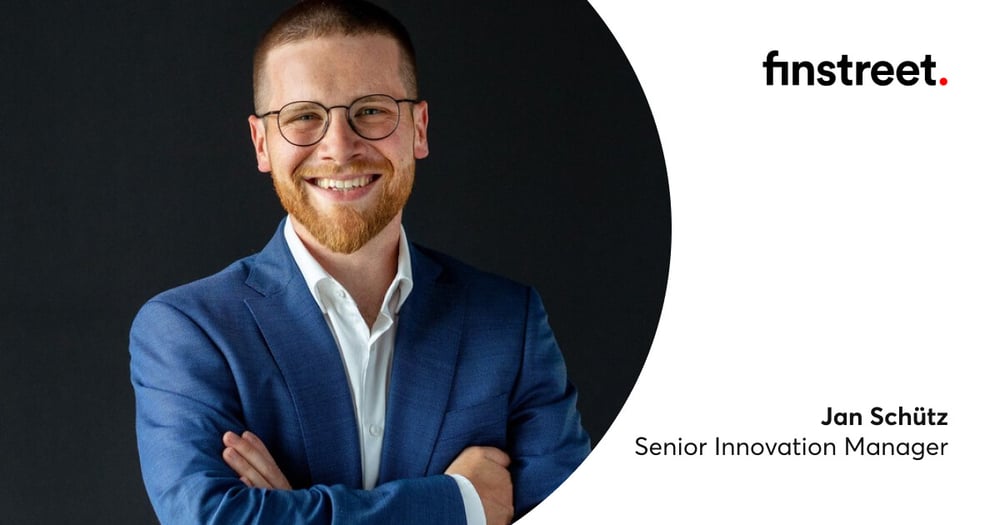
We talked with Jan Schütz, Senior Innovation Manager at finstreet, about the current situation in the financial services industry, what it takes to create, implement and scale innovative solutions, and what we can expect from the industry in the future.
At finstreet, you develop, design, code, launch, and scale digital innovations for the financial industry. Tell me a little bit more about the company and your role in it.
Finstreet is a consulting company specializing in innovation and digitalization for the financial services industry. Our vision is to create successful digital business models for our banking clients, as well as Software-as-a-Service products and ventures.
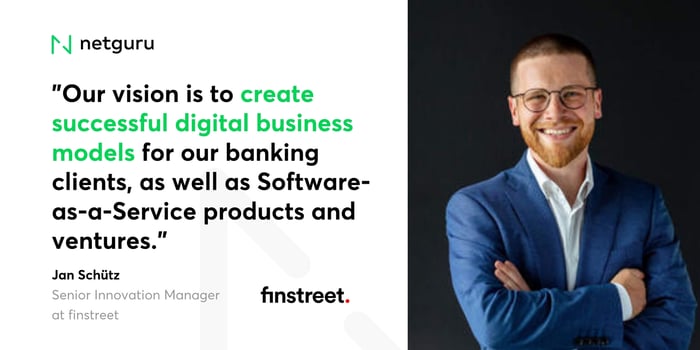
Finstreet’s founders all come from the banking industry and saw the need to digitalize it. After their first experience with clients, they realized that they needed people with the technical expertise and to create and implement the innovations, as well as great design to make their digital products a joy to use. Now the company has business developers, technical experts, UI and UX experts, designers, and marketers, with strong banking knowledge as the backbone.
I come from a business background, but now I’m responsible for the technical implementation of most of our projects and products, and I'm also part of our information and data security task force.
Let's talk about the current situation in the industry. The banking sector has been going through changes over the last several years, the fintech disruption being a big topic of conversation. What issues are your banking partners focused on now?
Traditional banking, as in savings and lending, has a profit problem due to the long-lasting phase of low-interest rates. There's a need for cost-cutting and creating other revenue streams.
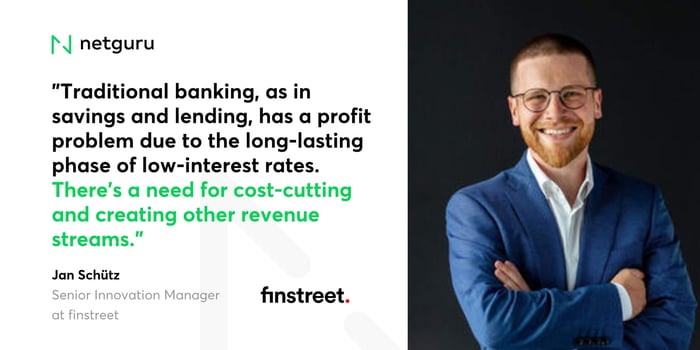
There are regulatory requirements. PSD2 is still an important topic, as is implementation of frameworks like Basel III and the upcoming Basel IV, stress tests for the bigger banks, but also the influence of new technologies like cloud computing and infrastructure. Information security management is another pressing issue, as well as competition from new banks and fintech companies.
However, the number one topic over the last year has been the COVID-19 pandemic.
How did the pandemic affect the way you work, both internally and with your partners?
The pandemic accelerated the need for the banks to go through digital transformation. Suddenly they needed to have employees work from home, while still working with paper and little digitized data. Some banks didn’t even have laptops that employees could use from home.
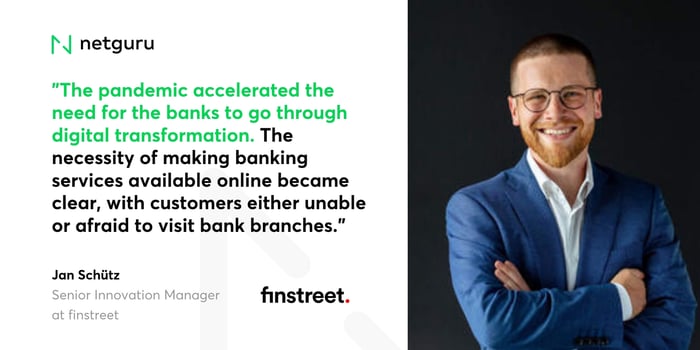
The necessity of making banking services available online became clear, with customers either unable or afraid to visit bank branches. More businesses needed to apply for loans. A financing portal that we created with our partners in Germany was actually referred to by the German minister of economics as the way to receive liquidity because it was the only way to apply for financing in a fully digital way.
Some banks tried to make more of their services available online, but they only digitized the frontend while still processing the applications manually. The high number of loan applications during COVID-19 naturally resulted in long processing times.
Let's say I have an idea to revolutionize the banking industry. Where do you think I should start? Should I start with the “why?,” or first do an experiment and see if it works? What's your approach?
Always start with the “why.”
Firstly, set a general objective and then analyze the current situation. You need to understand the problem and be sure that the proposed solution actually solves it, and not just treat the symptoms. The same way a doctor would treat an illness and not just the coughing. At finstreet, we call this “problem-solution-centered-thinking.”
Let’s say we want to increase the profit contribution of SME loans. There are two angles from which we could approach the issue: The financing volume and the available capacities. It might be easy to increase the financing volume by increasing marketing spending, but if this meets the small margins within banks and the limited workforce, it's not a long-term solution. In our understanding, the fundamental problem is manual processing and low efficiency. That brings you one step closer to providing customer satisfaction because you solve the problem of the customer waiting too long for the loan. It also lays the foundation for increasing sales afterwards.
If you have a number of seemingly good ideas, do you have a way to find out which one will make for the most effective solution? How do you prioritize when deciding what to work on?
We have a set of questions that we use to rank each idea.
- How big is the measurable increase in sales or efficiency, or the decrease in costs?
- What is the quality of the solution in terms of solving the problem and satisfying the needs of the user - the bank or the end customer?
- How is the technical feasibility in relation to the other criteria, especially the economic?
Speaking of which, in our opinion, you need to prepare an economic justification right from the start, as well as a clear and validated business case for each step, including relevant KPIs – an absolute must-have.
Once you’ve selected the idea and have a vision in place, how do you kick off the new project?
Before you can kick off the project, you need to have done your homework when it comes to the team and the environment, which is one of the biggest foundations of the innovation process.
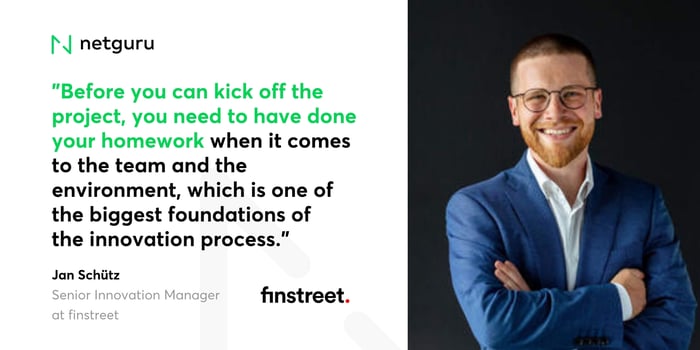
You need to create small teams with a specific mindset. The team members need to have the ability to think outside the box. People stuck in old structures and behaviors, using phrases like “that’s the way we’ve always done it,” won’t help you innovate.
The team should have the creator, who quickly generates new patterns and disrupts the systems, the owner who brings knowledge and stability into the system, and the broker who knows people with the necessary expertise and connects them, disrupting existing structures and behaviors.
When you put the creator and the owner together, you get ideas. Connecting the owner and the broker will help you evaluate an idea. The broker and the creator will push ideas forward. If you bring all of them together, you get elicitation, solution formation, and evaluation in one group, which allows you to go through the whole innovation cycle with the best ideas.
Team members with different types of knowledge are essential – banking expertise, technical expertise, regulatory, legal, UX, UI, marketing, etc. The work environment needs to empower trial and error – a “Let's try this” mentality. Give the people time to focus on the innovation process.
One interesting thing we’ve learned over the years is that sometimes a change of location and even clothing is also necessary. We are always amazed at how differently our clients act when we invite them to our office for a creative session where they don’t have to suit up. Unfortunately, it wasn’t possible recently due to the pandemic. We are really looking forward to being able to do this again.
What does the cooperation between your team and the client normally look like?
Nearly all of our projects start the same.
The client brings the knowledge of the bank itself – its culture, products, and internal processes. Finstreet brings the mindset and relevant roles, as well as business expertise and knowledge of different approaches.
There's one important issue for us: We can't, and won't, dictate the change process in a bank. It needs to be developed by the bank itself in order to reach widespread acceptance. In all of our projects, we try to enable our clients to fill the necessary positions and roles for themselves.
The time frame depends on existing structures, the client’s goals, and the complexity of the problem. It can last anywhere from between four workshops in four weeks for the initial set up for an initiative or innovation cycle, to months or even years, including the founding of a dedicated entity, doing marketing, etc.
We see that banks are already reacting to the necessity of having an innovation-friendly environment. Innovation labs have created many customer touchpoint initiatives with great customer-centric ideas. However, innovation often stops after developing an idea. One of the reasons is that there's not enough experience in the innovation labs to create a valid MVP, both technically as well as entrepreneurially. That's where we try to help.
Innovation at its core is about creating something new and that’s what makes it so exciting. How do you stay focused on the less glamorous work of keeping the initiative on track until completion?
You need to iterate on the current status constantly in two very important dimensions: the problem-solving one, which decides whether you are reaching the goal of the innovation cycle, and the financial dimension that allows you to proceed with your initiative.
To track the status in the first dimension, we always start an initiative by setting hypotheses and validating them over time based on feedback. You need to start to gather standardized feedback on an MVP as early as possible, but even before that, on the idea of the implementation, to make sure it’s as customer-centric as it can be.
As for the financial dimension, you need to compare the KPIs with the current status of the project and if it's not going well, then you react.
There’s a lot of risk in doing innovation. For example, Microsoft claims that only a third of their initiatives are successful, while for others, the figure may be as low as 10%. How do you react when things go wrong? When do you decide to pivot or kill an initiative?
Killing might be a little strong. As I mentioned earlier, you have to continually check the relevant dimensions.
In the problem-solving dimension, the question is whether the solution solves the underlying problem. Will the product/market fit be achieved? That is, will the answer be accepted and valued by the user in the real world? That's done via feedback.
In the financial dimension, the question is, does the solution reach a KPI? If not - not good. There's no room for a pet project to continue.
Still, it might not be necessary to kill the whole initiative, but rather to question whether the problem was approached from the right angle. Maybe it's essential to just try the next idea.
It’s important to be honest with yourself. If something looks like a duck and walks like a duck it is most probably a duck, so don't go on.
We’ve talked about experimentation and the VP phase. Still, if you ask an executive, they'll usually say the most important step is the execution, how we end up with the final solution, and how you scale it. Can you share with us your best practices for this final phase?
You need to consider the target users. Start with the internal perspective: bank employees are your customers and your users. Make sure they accept your solution, and you do that by getting their feedback during the ideation and creation phase.
Then look at the end customer’s perspective. In order to scale, it’s important to have a validated and optimized MVP. Only then you need to invest in marketing and growth.
You also need to measure. If you can't assess which Euro brought which success, you will fly blind, and you won’t be able to optimize the investment in marketing.
After that, it’s trial and error. Start testing with small budgets. What works for the specific customer group? Do we meet the wording of the customer group? Can we try a new channel and combine the test balloons with the already validated MVP? You'll have users meeting a product or an MVP that already has a relatively high conversion and retention rate, optimizing the investment into marketing.
Still, you can't just take a look at one perspective. In order to implement the big picture, the grand vision, you'll need to prepare for covering both perspectives. To use the SME example again, if you have solved the problem of high manual workload and slow processing time, then you can increase the sales without overloading the employees and increase the profit contribution of SME loans even further. Then the mission is accomplished.
Looking into the future, how do you see the battle between traditional banks and fintechs playing out over the next year?
I think the upcoming battle won’t be between fintechs and banks, but between the existing players in the financial services sector, including both banks and fintechs, and new players such as Google, Amazon, Facebook, and Apple. For years, the key business for these companies has been to fill the customer touchpoint on an everyday basis. Even the German airline Lufthansa recently created a banking app.
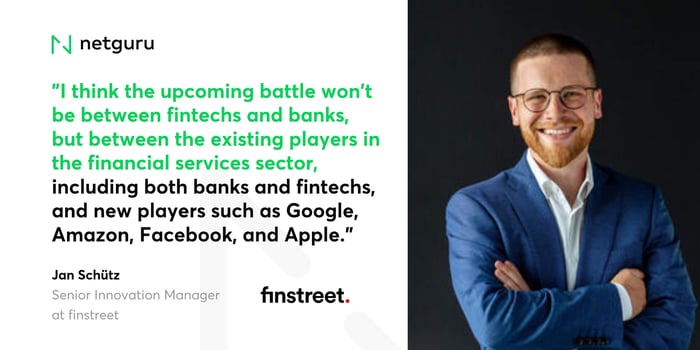
I don’t know about you, but I spend considerable time on Amazon and Instagram on my phone. Banks need to react to that, and they are starting to with the beyond banking strategy. Some examples of that are the German Sparda-Bank’s TEO app and the Austrian Erste Bank’s app, George.
Creating ecosystems that move customers’ primary needs to the front and treating the financial products as secondary is something banks need to work on.
I'd like to close with a question about the blockchain. There's obviously a lot of hype around it. Is that something that you expect to be working with a lot in the future?
In the near future, not too much. The feedback from our clients is still somewhat reserved. We don’t push it because, in our opinion, banks have more pressing needs to deal with first, like gaining broad access to customers online and reducing existing costs, primarily through automation, using technologies like RPA (Robotic Process Automation). They also should work on infrastructure, connecting systems to enable the use of data across multiple software platforms. Finally, our clients are starting to use AI, to optimize the return on investment in marketing in one case and to make credit decisions in another. Blockchain is a big thing and it’s going to be very important, but we’re not quite there yet.






%20(1).jpg?width=362&height=241&name=tablet%20and%20flowers%20(1)%20(1).jpg)
